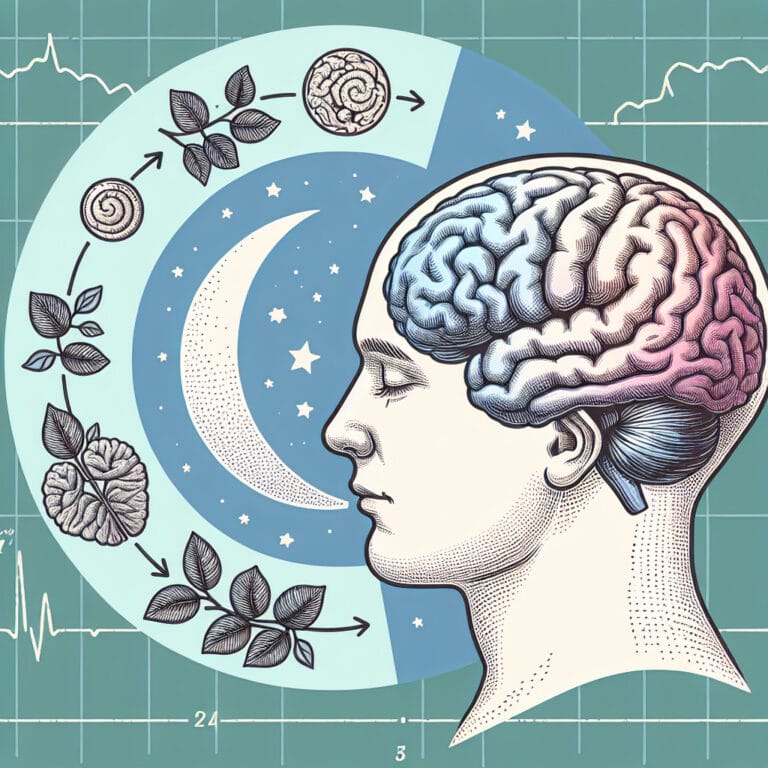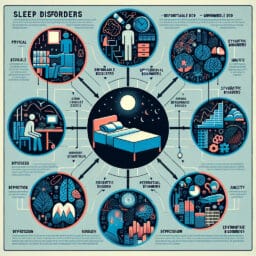
Understanding Somnolence: A Comprehensive Definition and Guide
Table of Contents
- Introduction
- Understanding Somnolence
- Causes of Somnolence
- Diagnosis and Treatment of Somnolence
- Conclusion
- Frequently Asked Questions
Introduction
Somnolence, often colloquially referred to as sleepiness or drowsiness, is a state of strong desire for sleep that can be disruptive to daily activities. The science behind somnolence involves complex interactions within our brain and body during the sleep cycle, with various factors such as lifestyle habits, medical conditions, and certain medications potentially influencing this intricate balance. It’s vital to comprehend this definition of somnolence and recognize its impact on both physical health – ranging from decreased energy levels to weakened immunity – and mental health including mood fluctuations and impaired cognitive function. More than a mere inconvenience, excessive daytime somnolence can signal underlying health issues which necessitates attention. Hence understanding somnolence doesn’t just help individuals identify the causes but also guides towards suitable diagnosis process – encompassing assessment of symptoms, medical history review and possibly sleep studies – leading onto diverse treatment options like lifestyle changes, therapy or prescribed medication as per individual need. Ignoring persistent somnolence could lead to significant complications over time; thus addressing it promptly is crucial. By demystifying the term ‘somnolence’, we empower ourselves with knowledge that aids in proactive healthcare management for holistic well-being.
Understanding Somnolence
Peeling back the layers of the definition of somnolence reveals a rich tapestry intricately woven with scientific, physiological and psychological threads. At the heart of understanding somnolence lies the science behind it, which begins with a dive into our body’s sleep cycle. This biological rhythm, orchestrated by our brain, alternates between periods of wakefulness and slumber and plays a pivotal role in influencing our state of alertness or drowsiness. A closer look uncovers an array of factors that can skew this delicate balance towards excessive daytime somnolence – from lifestyle factors such as irregular sleeping patterns to medical conditions including sleep apnea or narcolepsy and even certain medications that induce drowsiness.
The impact of somnolence on health is multifaceted. Physically, experiencing persistent sleepiness can sap energy levels, weaken immunity and impair motor skills – making routine tasks cumbersome while increasing susceptibility to illness. Mentally too, unremitting somnolence takes its toll by clouding cognition, stirring mood swings and inhibiting concentration – casting shadows over one’s quality of life.
Recognizing these potential causes triggers the onset for diagnosis process which includes evaluating symptoms and reviewing medical history – sometimes supplemented with specific tests like polysomnography (sleep study). Based on this comprehensive assessment arise tailored treatment options spanning from lifestyle modifications (like exercise regimen) to therapy sessions or prescribed medications designed specifically to counter excessive sleepiness.
The noun ‘somnolence’ might seem like just another entry word in medical dictionaries but its importance cannot be underestimated considering how intimately intertwined it is with overall well-being. Here’s a recap: Unraveling ‘somnolence’ lets us appreciate the complex interplay between sleep cycle disruption due to various influences leading onto detrimental impacts on physical & mental health; thus underlining why addressing it promptly isn’t optional but crucial. So watch out for signals your body sends. It might just be trying to tell you something about the sleep it’s been getting (or not).
| Title | Content | Image |
|---|---|---|
| Understanding Somnolence |
|
Causes of Somnolence
Deeper exploration into the definition of somnolence unveils a complex interplay of factors that influence this state. An integral part is played by lifestyle factors – irregular sleep patterns, poor diet, inadequate physical activity or high stress levels are known to disrupt our natural sleep cycle and contribute to experiencing somnolence. Additionally, certain medical conditions such as sleep apnea, narcolepsy or depression can significantly increase daytime somnolence. The very science behind somnolence underscores how these conditions interfere with the quality of sleep by disrupting the rhythm of our brain’s wake-sleep regulation.
Another significant contribution comes from medications, both over-the-counter and prescription drugs. Antihistamines, sedatives or tranquilizers for instance can induce drowsiness – an unwelcome side-effect if taken during daytime hours. Equally influential are certain types of antidepressants and anti-anxiety medications which may cause excessive sleepiness despite their therapeutic benefits.
The confluence of lifestyle factors, medical conditions and medications thus creates a unique pattern in each individual’s experience with somnolence but what remains constant is its impact on health – both physical and mental. Fatigue, weakened immunity or impaired cognition resulting from persistent daytime somnolence poses a concern that necessitates proactive diagnosis and versatile treatment options including lifestyle changes or therapy sessions besides medication adjustments where required.
The importance of addressing somnolence cannot be emphasized enough considering its multi-dimensional influences on overall well-being – an understanding that impels us not only towards effective management but also towards prevention strategies wherever possible. After all, at the heart of well-rested lives lies not just adequate slumber but also quality wakefulness – making every word about ‘somnolence’ significant indeed!
| Cause | Explanation |
|---|---|
| Lifestyle Factors | Irregular sleep patterns, poor diet, inadequate physical activity, and high stress levels can disrupt the natural sleep cycle and contribute to experiencing somnolence. |
| Medical Conditions | Conditions such as sleep apnea, narcolepsy, or depression can significantly increase daytime somnolence by disrupting the rhythm of our brain’s wake-sleep regulation. |
| Medications | Both over-the-counter and prescription drugs, including antihistamines, sedatives, tranquilizers, certain types of antidepressants and anti-anxiety medications, can induce drowsiness or excessive sleepiness, contributing to somnolence. |
| Impact on Health | Fatigue, weakened immunity, and impaired cognition resulting from persistent daytime somnolence are concerns that necessitate proactive diagnosis and treatment. This includes lifestyle changes and therapy sessions, in addition to medication adjustments where required. |
| Importance of Addressing Somnolence | Considering its multi-dimensional influences on overall well-being, it’s crucial to focus on not just managing but also preventing somnolence. This emphasizes the need for both quality sleep and wakefulness. |
Diagnosis and Treatment of Somnolence
Digging deeper into the intriguing science behind somnolence presents a keen understanding of the processes involved in diagnosing this state. Captivatingly, it’s not as simple as ticking off symptoms from a checklist. A comprehensive diagnosis process is initiated with an evaluation of sleep patterns, lifestyle habits and any potential medical conditions that could be influencing an individual’s sleep cycle. In certain cases, special tests like polysomnography may be required to accurately gauge levels of daytime somnolence. Once established, the approach to counteract excessive sleepiness isn’t one-size-fits-all but as unique as each person experiencing it.
In terms of treatment options, they are diverse – curating a personalized plan to suit individual needs. It often begins with advocating lifestyle changes such as regularizing sleeping hours or revising dietary habits which can significantly improve overall health and subsequently alleviate somnolence. Similarly, addressing health conditions that might contribute to disrupted sleeping patterns is crucial too – these may include treating sleep apnea or adjusting doses for certain medications known for inducing drowsiness.
Therapy sessions focusing on stress management or cognitive behavioral techniques also become part of this holistic approach towards mitigating impacts of somnolence on physical and mental well-being. Pooling all these insights forms our recap: Understanding Somnolence isn’t just about knowing the definition but delving into its causes, identifying signs and seeking appropriate help – because every nuance holds significance in managing this state effectively!
Conclusion
Nestled within the expansive realm of sleep science lies the intriguing concept of somnolence, a state characterised by an overwhelming urge for slumber that can disrupt everyday activities. The definition of somnolence takes us beyond mere drowsiness or sleepiness; it highlights a complex interplay between our brain and body during the sleep cycle. Factors influencing somnolence are diverse, including lifestyle habits, medical conditions and certain medications. Understanding Somnolence underscores its potential impact on both physical and mental health – from decreased energy levels to impaired cognitive function. But worry not! With comprehensive diagnosis processes and tailored treatment options – encompassing lifestyle changes, therapy, or medication adjustments – managing this condition is within reach. Remember that behind every entry word in medical dictionaries like ‘somnolence’, there’s a wealth of knowledge guiding us towards proactive healthcare management for holistic well-being. Take note; every nuance about experiencing somnolence holds significance in living wakeful lives amid restful nights!



